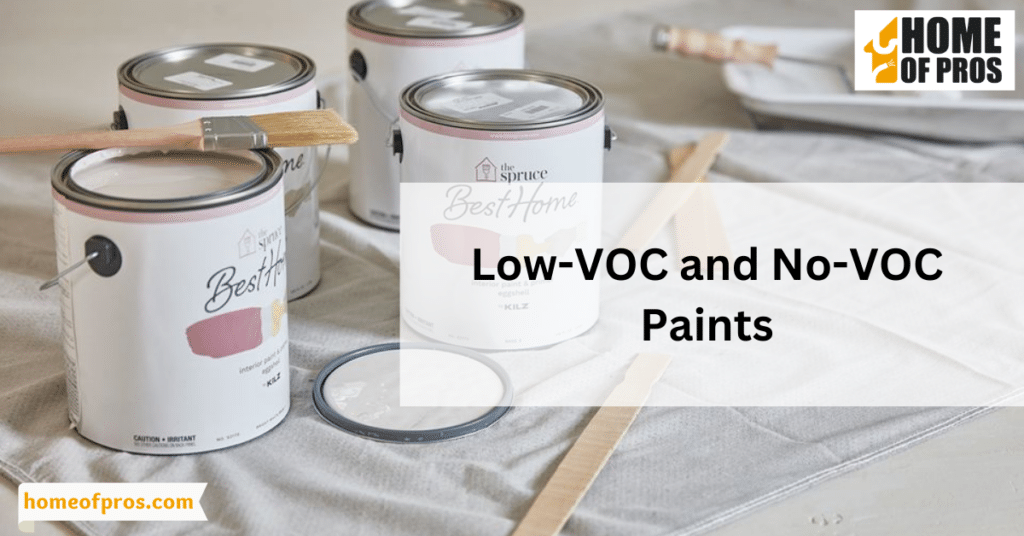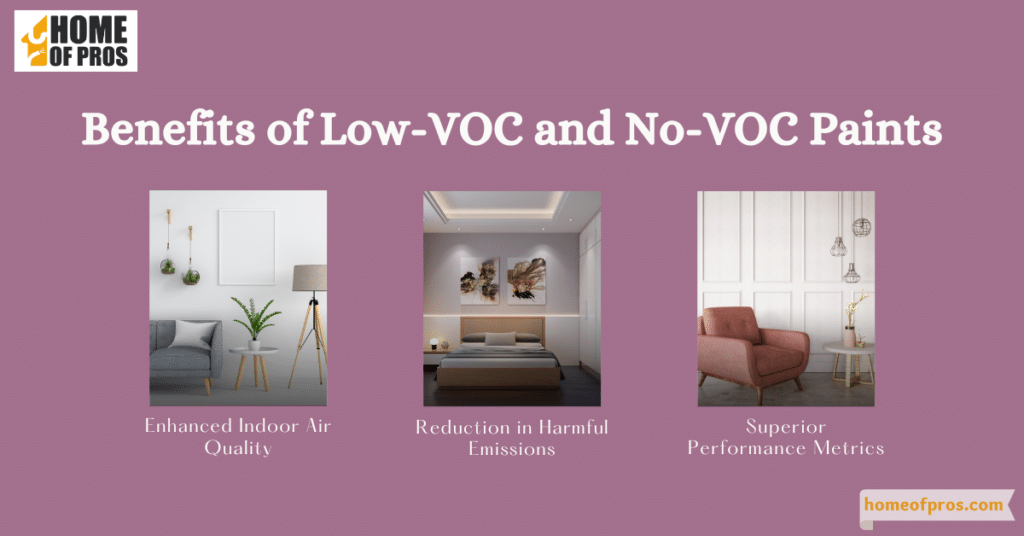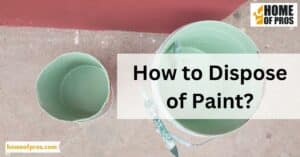Low-VOC and No-VOC paints are revolutionizing the painting industry by offering eco-friendly alternatives to traditional products. By significantly reducing or eliminating volatile organic compounds, these paints contribute to better indoor air quality and a safer environment. Opting for these options means making a conscious choice for healthier living spaces and a more sustainable planet.
Volatile Organic Compounds (VOCs) are carbon-based chemicals found in many products, notably traditional paints. These compounds can elevate indoor air pollution, leading to potential health issues like headaches and dizziness. Moreover, outdoors, VOCs contribute to smog formation, harming our health and the environment. It’s crucial to be aware and choose products with reduced VOC content for a healthier living space and planet.

The Rise of Low-VOC and No-VOC Paints
Historically, paints were laden with VOCs, which provided certain qualities like durability and a smooth finish. Over time, as the detrimental health and environmental impacts of VOCs became evident, there was a clear need for safer alternatives.
In response, the paint industry witnessed the rise of low-VOC and non-VOC paints. These eco-friendly alternatives have gained popularity due to growing environmental consciousness and rising health concerns among consumers. Today, they represent a significant shift in the market, emphasizing both health and sustainability.

Benefits of Low-VOC and No-VOC Paints
In our eco-conscious era, the emphasis on healthier and sustainable choices has permeated various industries. Among these, the paint industry stands out with its significant move towards low-VOCnon-VOC and no-VOC paints. These aren’t just buzzwords but represent tangible benefits for both consumers and the environment. Let’s delve deeper into the advantages they offer:

1. Enhanced Indoor Air Quality
Traditional paints, with their high VOC content, have been identified as a significant contributor to indoor air pollution. Switching to Low-VOC and No-VOC paints can dramatically improve the air quality within our homes and workspaces.
Cleaner air has multiple benefits: it can reduce the risk of respiratory issues, minimize allergens, and offer a safer environment, especially for children and the elderly. In essence, choosing these paints can be a significant step towards fostering better health and enhancing our overall sense of well-being.

2. Reduction in Harmful Emissions
Environmentally speaking, the paints we choose have a broader impact beyond our walls. High VOC paints release harmful compounds not just during the painting process, but as they continue to off-gas over time.
By opting for low-VOC and non-VOC alternatives, we significantly reduce these emissions. This contributes to a noticeable decrease in environmental pollutants, ensuring our choices are not just beneficial for us but also for the world around us.

3. Superior Performance Metrics
One might assume that making a product eco-friendly means compromising on its performance. However, this isn’t the case with Low-VOC and No-VOC paints. Many modern formulations of these paints have been designed to be robust and long-lasting. Whether we consider factors like durability, drying time, or the overall finish, these eco-friendly options often meet or exceed the standards set by traditional paints. This means homeowners don’t have to sacrifice quality for eco-consciousness.
As we move towards more informed choices in our daily lives, the appeal of low-VOC and No-VOC paints becomes evident. They represent a blend of quality, health, and environmental considerations. With both homeowners and professionals making the shift, it’s evident that the realm of painting is evolving, placing health and sustainability at its core.

Decoding Labels: Understanding What’s in Your Paint Can
Navigating the paint aisle can be a daunting task, especially with a myriad of labels staring back at you. To make an informed choice, it’s essential to understand what these labels signify and what they mean for you and the environment.
Table: Decoding Paint Can Labels
| Label Aspect | Description |
|---|---|
| Labeling Standards | Regulatory bodies set specific thresholds for VOC content. Look for trusted certifications indicating compliance. |
| “Low-VOC” vs. “No-VOC” | “Low-VOC” paints contain reduced amounts of VOCs compared to traditional paints, while “No-VOC” paints have minimal to none. |
| Other Green Certifications | Beyond VOCs, some paints carry labels like “Green Seal” or “EcoLogo”, indicating broader environmental considerations. |
Arming yourself with knowledge about paint labels ensures you’re not just bringing color into your home, but also health and environmental consciousness. So, the next time you’re out shopping for paints, take a moment to decode the labels—it’s a small step towards a bigger, greener change.

Popular Brands and Products in the Market
The push towards eco-friendly paints has prompted many renowned brands to innovate and offer Low-VOC and No-VOC solutions. As consumers seek healthier alternatives, certain brands have emerged as leaders in this green revolution.
- Benjamin Moore’s Natura: A no-VOC paint that doesn’t compromise on color selection or performance.
- Behr Premium Plus: Lauded for its low-VOC content, this line also boasts of exceptional durability and coverage.
- Sherwin-Williams’ Harmony: Beyond being low-VOC, this paint actively reduces indoor odors and formaldehyde.
- Clare Paint: A newer entrant to the market, Clare prioritizes transparency, offering no-VOC paints with an easy-to-understand ingredient list.
- Ecos Paints: Distinguished by its exhaustive list of no-VOC products, from primers to specialized finishes.
As the paint industry evolves, these brands represent a shift towards products that care for both the environment and consumer well-being. Their popularity not only underscores their quality but also the growing global emphasis on sustainable choices. The future of painting is not just about aesthetics; it’s about responsibility and health.

Considerations for Homeowners and Professionals
For homeowners and professionals alike, the switch to low-VOC and No-VOC paints is both a conscious and rewarding decision. Yet, like any significant change, transitioning smoothly requires a little forethought and preparation.
- Start with Research: Before making a purchase, familiarize yourself with leading brands and their product offerings. Not every low or no-VOC paint will suit every project, so choose wisely.
- Ventilation Matters: Even if you’re using low-VOC or no-VOC paint, proper ventilation during painting ensures any odors dissipate quickly and the paint dries faster.
- Compatibility Check: If you’re painting over a surface previously covered with high-VOC paint, consider using a compatible primer for a seamless finish.
- Test a Patch First: As with all paints, it’s wise to test a small patch first. This way, you can gauge the paint’s finish and drying time without committing to a large area.
- Seek Recommendations: Ask fellow professionals or neighbors about their experiences with specific brands or products. First-hand testimonials can offer invaluable insights.
Transitioning to low-VOC and non-VOC paints represents more than an eco-friendly choice—it’s an investment in healthier living spaces. With these considerations in mind, both homeowners and professionals can ensure their shift is both smooth and impactful.

Conclusion
Making the switch to Low-VOC and No-VOC paints is a testament to the evolving priorities of today’s homeowners and professionals. As we recognize the profound impact of our choices on health and the environment, opting for eco-friendly paints emerges as both a responsible and forward-thinking decision. In this journey towards sustainability, every small choice counts, paving the way for a greener, healthier future.












